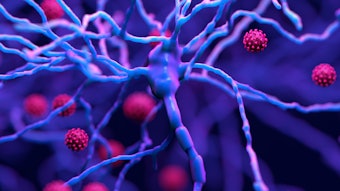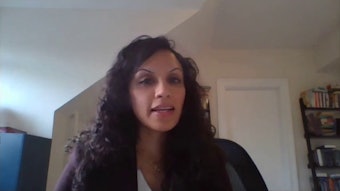The need to talk about race: A conversation among colleagues
Shedding light on the discussion of race during the Nursing Symposium.

Prior to Wednesday’s session “Let’s Talk About Race” during the Nursing Symposium, Stroke News spoke with the three presenters about the importance of—and discomfort surrounding—talking about race.
The speakers are Gayenell S. Magwood, PhD, professor of nursing at Medical University of South Carolina in Charleston; Theresa L. Green, BScN, conjoint professor of rehabilitation nursing at the University of Queensland in Herston, Australia; and DaiWai M. Olson, PhD, professor of neurology and professor of neurosurgery at UT Southwestern Medical Center in Dallas, Texas.
Stroke News: Why is it important to talk about race?
Olson: We have to talk. And the “we” is all of us. And it’s really uncomfortable. It’s going to be uncomfortable, and we have to be okay with the fact that this is uncomfortable.
It’s important to me to have the conversation because I’m a scientist. I want to know as close to the truth as I can get. The only way I can really get closer to the truth is to talk to other scientists. Part of the truth includes race and ethnicity.
And as uncomfortable as I am, I need to understand race because that’s the only way I can add truth to what I am studying. I study patients with neurological injury. Even if I am not specifically studying race, race plays into what I’m studying. It plays into some element of everything we do. If I would never have gone to the ocean, imagine how much information I could get from someone who had actually been there. I would have to talk with them to understand this concept “ocean.”
Name any social construct and the only way to understand it comprehensively is to talk to people.
Magwood: We need to talk about race and racism because sometimes people do not recognize race is socially constructed—that all forms of racism perpetuate health disparities. This is because they have not done the work to learn more, or, unfortunately say, “That’s in the past. We are beyond that.”
Neither society nor health care systems are beyond “that.” This means doing work, and it means having conversations and listening to the other person as well as actions individually and collectively. If we cannot actively listen to each other—even as clinicians, even as researchers—and begin to look at and unpack the complexity around when we say, “let’s talk about race,” then how can I trust you to listen and unpack what is in front of you whether it is a colleague, a patient or a research participant?
Stroke News: Does “race” mean the same thing in Australia as the United States?
Green: I believe so—it is the word used to describe our biological (typically physical) characteristics and usually defined by skin color for example, such as White, Black.
Stroke News: Are there racial disparities in health care in Australia?
Green: Yes, in access to health care, rural/remote living, ethnocultural beliefs about health and access to health care services.
Stroke News: What drives the conversation about race in Australia?
Green: The growing ethnic diversity in Australia due to immigration is one driver; respect for our Aboriginal and Torres Strait Islander (ATSI) cultural beliefs is another. Most hospitals in Australia have ethnoculturally diverse and, more specifically, ATSI cultural liaisons on site. In some centers, there are now ATSI traditional healers embedded within the care team to help bridge some of the cultural gaps.
Also, many ethnically diverse groups live in rural areas that are remote from major western health care centers. This is a driver for change in how health care and other government and social services are organized and delivered. Providing services to remote areas is a focus for telehealth technology, from acute triage for patients living within flying distance for LifeFlight services to a major stroke center for acute treatment, to providing nursing and allied health services through telehealth portals.
Stroke News: What is the problem with being “color blind” in treating patients?
Magwood: Color blindness, by its definition, means poor, deficient vision. People need to be seen and heard for who they are, including their social and structural environment. That is a true holistic and patient-centered approach.
Olson: Being agnostic to race sounds like you’re being good, but it also means, “I am going to ignore a certain part of who you are and what makes you you.”
Green: If you are color blind in treating patients, you may miss recognizing and investigating the ethnocultural characteristics that influence disease, such as diet and exercise. While being color blind is very important in ensuring equitable access to services to meet health needs (e.g., access to imaging, diagnostic services, medications), it is also important to understand the influence of racial and ethnocultural behaviors on health. These should not marginalize people, but in thinking about stroke for example, awareness of social determinants of health that may affect your patients are extremely important to discuss.
Stroke News: How does race affect outcomes in vascular health?
Magwood: People will say race is a risk factor, but we are really looking at the social and structural determinants of health. There are systemic issues that make certain groups−and particularly people of color−more at risk because of social disadvantages (historical and ongoing), for example, in educational resources, poverty, unequal access to health care and, yes, even racism. These things, among others, are social determinants of health, and yes, these are in fact contributing to health inequities.
For example, in stroke, where we see certain racial groups or people of color with higher risk, we are finding it is much more complex than race alone. There are marked disparities we see in vascular disease involving issues of inequities in social determinates of health, access to health care, and even deeper, are biases in clinical practice.
Stroke News: If you could get one message to health care professionals, what would it be?
Green: While there are genetic and physiological differences in predisposing factors leading to health issues such as cardiovascular and cerebrovascular disease, racism is a factor in health disparity. These health disparities are preventable by recognizing barriers to achieving optimal health and identifying unconscious biases related to racial and ethnic differences.








